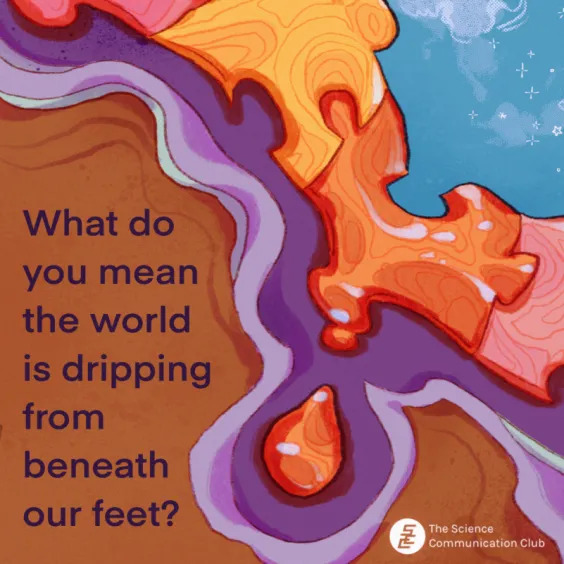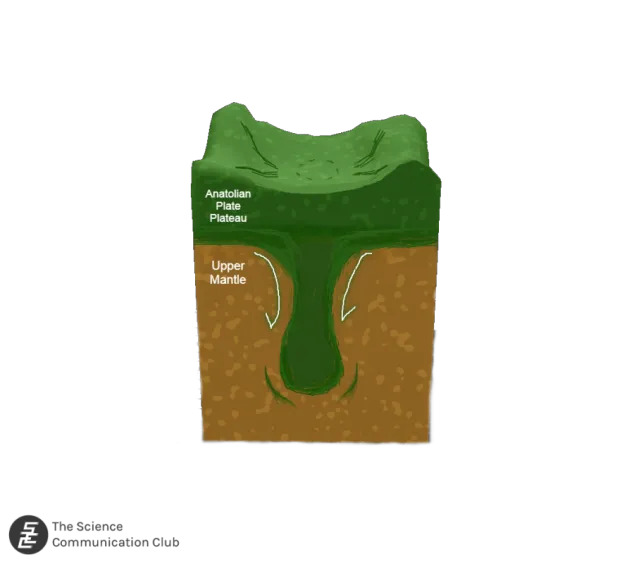
Written by Erica Rose
Illustrated by Cheryl Nong
The world shifts every day beneath our feet. Besides the world actually hurling through space, the land beneath our feet is also in motion. The large puzzle pieces that form the surface of the Earth create some of the most amazing and dangerous wonders of our planet. Turns out sometimes these puzzle pieces do things we don’t expect, and as a result affect our planet in new unexpected ways.
In order to talk about why our planet ‘dripping’ is so strange, first we have to know a bit of backstory. The basis of this is the theory of plate tectonics. Basically, we can think of plate tectonics as if the surface of the Earth was made up of a bunch puzzle pieces, called plates. They float on and glide across the upper mantle (the layer under Earth’s crust). These plates have been moving and changing our planet for billions of years. They influence many aspects of our planet, including the climate and the physical landscape. They are what quiet literally move mountains!
Generally, the plates move, shift, and interact at about the same rate our fingernails grow (which is pretty fast relatively, but slow on such a large scale). The surface of the Earth is broken into seven major plates and many smaller ones. This means that tectonic processes are constantly happening all over the globe! Where these plates connect is where this slow movement can result in huge physical events. Generally speaking, plates interact in three ways: there are convergent boundaries (moving together), divergent boundaries (moving apart), and transform boundaries (sliding past each other). Or a combination there of. The different boundaries make different structures on the surface. For example, convergent boundaries can form volcanoes, mountains, and trenches. And divergent boundaries can create large valleys or even be slowly pulling continents apart.
But frequently the plate tectonics on Earth are not as simple as that. In most cases many processes and forces are happening at once.

In Türkiye for example, strange processes and landscapes are occurring as this is being written. Türkiye is on a small plate (the Anatolian plate), surrounded by three very large plates from the adjacent continents. This makes for a lot of strange things happening. We can expect it to be a very tectonically busy area, which it is, but there’s more to the story than just where the plates collide. Researchers from the Earth Sciences Department here at the University of Toronto have a proposed explanation for some of the landscapes that are changing, seemingly without reason, in the middle of the Anatolian plate.
They call it ‘drip tectonics’. Think of it like this: the Anatolian plate (Türkiye) is being compressed or squished, like if you were to squish the end of a pumpkin seed. As a result, this plate has thickened (like compressing a slab of playdough). This added mass to the middle of the plate, and as a result (along with other factors), some of this material is able to ‘drip’ back into the upper mantle.
The thickened part is in central Türkiye, which is a large plateau (area of high, flat elevation). This is where the ‘drip’ is occurring. Imagine this process like honey dripping – very slow and viscous. As this ‘drip’ sinks and hangs there, it is pulling the surface it is attached to down with it, which is the plateau. So as such, the plateau is actually sinking down with it and losing elevation!
This proposed mechanism is based on fluid mechanics. A good example of this mechanism is if you were to drop a marble in a jar of honey. As the marble is submerged into the honey there will be a small depression at the surface where it entered – as in it pulled the surface down, creating a basin. This is the same phenomenon! This theory is newly studied so the implications and long-term affects on the area are still being debated and researched.
‘Drip tectonics’ could and likely will have a large impact on how we view continental landforms in the future. It will help us be able to answer many more big questions about structures and processes happening in the middle of tectonic plates all around the world! Just because there isn’t actually any plate movement there, doesn’t mean its independent to the many complex forces happening around it. The Earth is a complex and funny place. And apparently ‘drippy’…
Sources:
- A Julia Andersen, Oguz Hakan Göğüş, Pysklywec RN, Ebru Şengül Uluocak, Tasca Santimano. 2024. Multistage lithospheric drips control active basin formation within an uplifting orogenic plateau. Nature Communications. 15(1). doi:https://doi.org/10.1038/s41467-024-52126-7. [accessed 2024 Oct 1]. https://www.nature.com/articles/s41467-024-52126-7.
- Marshak S. 2019. Earth: portrait of a planet. New York W.W. Norton & Company.
- Gogus, Pysklywec RN, A. M. Celâl Şengör, Erkan Gün. 2017. Drip tectonics and the enigmatic uplift of the Central Anatolian Plateau. Nature Communications. 8(1). doi:https://doi.org/10.1038/s41467-017-01611-3.
- Putol R. 2024. Earth’s crust is “dripping” under Turkey. Earthcom. [accessed 2024 Oct 19]. https://www.earth.com/news/earths-crust-is-dripping-under-turkey/.